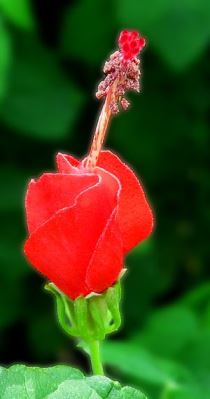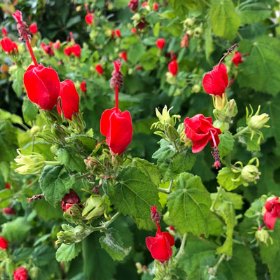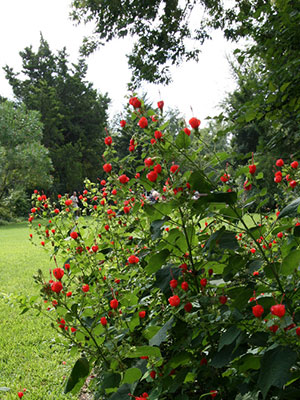
Turk’s Cap
I first planted Turk’s Cap in my then-new garden in April 1992. At the time the area where I planted it was only partially shady, being near to a couple of volunteer “fenceline” hackberries and a young red oak I had recently put in the ground.
When I planted the Turk’s Cap I had no knowledge of it at all
except from books and just took a stab at where to plant it. The name
intrigued me, plus the plant’s reputation for attracting hummingbirds.
And at the time a house on the end of our block had a big patch of
Turk’s Cap that bloomed every year and looked beautiful. So that was
encouraging.

|
|
I had just built a rough path of old bricks through that corner
of the yard, connecting a new concrete garden bench to a clump of
overgrown holly bushes where I contrived a “tunnel” through the holly
that formed a feature on the path. And the Turk’s Cap would be the only
other flowers in that area, once they got established.
That was 30 years ago. The holly clump is gone (victim of
root rot); the brick path is gone (recycled to widen another garden path
so it would allow my wife’s wheelchair to pass); the garden bench is
still there, but overgrown by a wisteria vine and now used only by a
couple of feral cats as a shady place to nap. But the Turk’s Cap is
still there, spread out over several square yards of ground and
thoroughly shaded by the red oak I had planted not long before them,
which is now at least 90 feet tall. The oak and the Turk’s Cap are
virtually the only survivors of all the things I had planted in that
corner of the yard. Yes, Turk’s Cap is durable!

|
|
Let me introduce you more formally. This spreading shrub, often
as broad as it is high, grows 2-3 ft., sometimes taller. The bright-red,
pendant, hibiscus-like flowers never fully open, their petals
overlapping to form a loose tube with the staminal column protruding,
said to resemble a Turkish turban, hence its most common name, Turk's
Cap. It is a member of the hibiscus family. A good ornamental for shady
sites and sunny sites alike, it is popular in cultivation and goes by
many English names including Turkcap, Turk's turban, wax mallow, ladies
teardrop and Scotchman's purse. It is native to Central America, Mexico,
and the Gulf Coast of the United States, particularly as an understory
shrub in coastal Texas and Louisiana. It is an important food source for
female and juvenile Ruby-throated Hummingbirds and Black-chinned
Hummingbirds. Each individual flower lasts two days but contains more
nectar on the first day. The fruit can be used to make jelly or syrup.
Both the fruit and flowers are used to make herbal teas.

|
|
It can be a wonderful plant for any wild garden, but also fits in
well in a “civilized” garden. The flowers are uniquely shaped. Their
color is truly brilliant, especially in the shady areas where they
usually grow. And hummingbirds are attracted to them as soon as the
flowers appear. So if you plant them, be sure to put them where you can
see them – not like mine, which have gotten so hidden away in the back
corner of the garden I have just gone more than a year without actually
seeing the flowers, until I had the path to the bench cleared recently
and carefully made my way back to a vantage point. They’re just coming
into flower and should bloom the rest of the summer if I keep them
watered. Calling all hummingbirds! And maybe the cats will make room on
the bench for me to sit there once in a while.





No comments:
Post a Comment